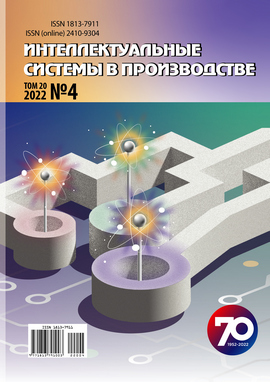Wind-Electric Installation Control Based on Vibration Drive Loading under Various Energy Unit Operation Conditions
DOI:
https://doi.org/10.22213/2410-9304-2022-4-56-63Keywords:
control, wind-turbine, height of measurement of wind, mathematical dependence, profile exponential law, loadingAbstract
Necessity of mathematical model description of the electric power production considering not only wind loading, but also drive loading under different modes of energy-unit operation by computerized control, promoting improvement of reliability indicators of modern wind-generators components, is proved. The problem, specifications of mathematical relation between generator rotor angular speed and wind speed, blade position angle and power consumption that provides the required range of wind speed within 5-20 m/s is solved, blade position angle variation within 0 - 2% under generator rotor winding current variation not exceeding allowable error (2%) and taking account parameters affecting asynchronous generator voltage stability: induction resistance, reduced induction resistance; stator winding phase resistance, reduced stator winding phase resistance, was solved. Research Necessity of wind-electrics unit control by non-stationary operating modes under the conditions of change of measurement height of wind speed that can lead to distortion of output control results caused by the big error of measured meteorological values and consequently, negative effect on energy-unit vibrating loading, is proved. The analysis of researches made, concerning change of wind speed measurement height for wind-turbine USW56-100 has shown, that wind speed measured at 10 m height, below energy-unit by 14 m is 1m/s smaller than the actual wind speed that may icrease the error between actual and nominal angular speed of rotor wind-turbine from 3% to 17% that exceeds limits of an admissible error (2%), and generates vibrating loading of energy-unit drive and consequently, demands control, wind speed measurement height alteration by means of exponential law of a profile.References
Серебряков Р. А. Перспективы развития ветроэнергетики // Точная наука. 2021. № 110. С. 2-13.
Серебряков Р. А. Теоретические основы математического моделирования вихревой ветроэнергетической установки // Точная наука. 2021. № 110. С. 23-30.
Многоагрегатная ветроэнергетическая установка для районов с низким ветровым потенциалом / С. С. Доржиев, Е. Г. Базарова, В. В. Пилипков, М. И. Розенблюм // Агротехника и энергообеспечение. 2021. № 2 (31). С. 45-52.
Пионкевич В. А. Математическое моделирование ветротурбины для ветроэнергетической установки с асинхронным генератором методом частотных скоростных характеристик // Вестник ИрГТУ. 2016. № 3. С. 83-88.
Emadifar R., Tohidi D., Eldoromi M. Controlling Variable Speed Wind Turbines Which Have Doubly Fed Induction Generator by Using of Internal Model Control Method // International Journal of Advanced Research in Electrical, Electronics and Instrumentation Engineering. 2016. no. 5. Pp. 3464-3471.
Balamurugan N., Selvaperumal S.Intelligent controller for speed control of three phase induction motor using indirect vector control method in marine applications // Indian journal of Geo Marine Sciences. 2018. no. 47. Pp. 1068-1074.
Vijayalaxmi B., Bheema K. Individual Pitch Control of Variable Speed Wind Turbines Using Fuzzy Logic with DFIG // International Journal of research in advanced engineering technologies. 2016. no. 5. pp. 45 - 52.
Subbaian V., Sasidhar S. Maximum energy capture of variable speed variable pitch wind turbine by using RBF neural network and fuzzy logic control // International Research Journal of Engineering and Technology. 2015. no. 2. pp. 493 - 500.
Haiying D., Lixia Y., Guohan Y., Hongwei L. Wind Turbine Active Power Control Based on Multi-Model Adaptive Control // International Journal of Control and Automation. 2015. no. 8. pp. 273 - 284.
Буяльский В.И. Оптимизационная модель учета условий нагруженности привода при разных условиях эксплуатации ветроэлектрической установки // Интеллектуальные системы в производстве. 2022. Т. 20, № 1. С. 43-48.
Буяльский В. И. Динамический анализ оптимизационной функции в рамках вибраций роторных систем ветроэлектрической установки // Интеллектуальные системы в производстве. 2022. Т. 20, № 2. - С. 50-60.
Буяльский В. И. Автоматизированная система управления ветроэнергетической установкой на базе прогнозирования скорости ветра и мощности потребляемой электроэнергии // Наука и мир : Международный научный журнал. 2017. № 9 (49). - С. 14-19.
Кривцов В. С., Олейников А. М., Яковлев А. И. Книга 2: Неисчерпаемая энергия. Ветроэнергетика : учебник. Харьков : Национальный аэрокосмический университет «Харьковский авиационный институт» ; Севастополь: Севастопольский национальный технический университет, 2004. 519 с.
Буяльский В. И. Метод повышения эффективности управления режимом работы ветротурбины // Энергетик. 2013. № 9. С. 34-37.
Д. де Рензо. Ветроэнергетика / пер. с англ. под ред. Я. И. Шефтера. М. : Энергоатомиздат, 1982.272 с. : ил.
Рыхлов А. Б. Закономерности изменения средней скорости ветра с высотой в приземном слое атмосферы на ЮВ ЕТР для решения задач ветроэнергетики // Учёные записки РГГМУ. 2011. Вып. 20. С. 26-34.
Downloads
Published
How to Cite
Issue
Section
License
Copyright (c) 2022 Владимир Иосифович Буяльский

This work is licensed under a Creative Commons Attribution 4.0 International License.


